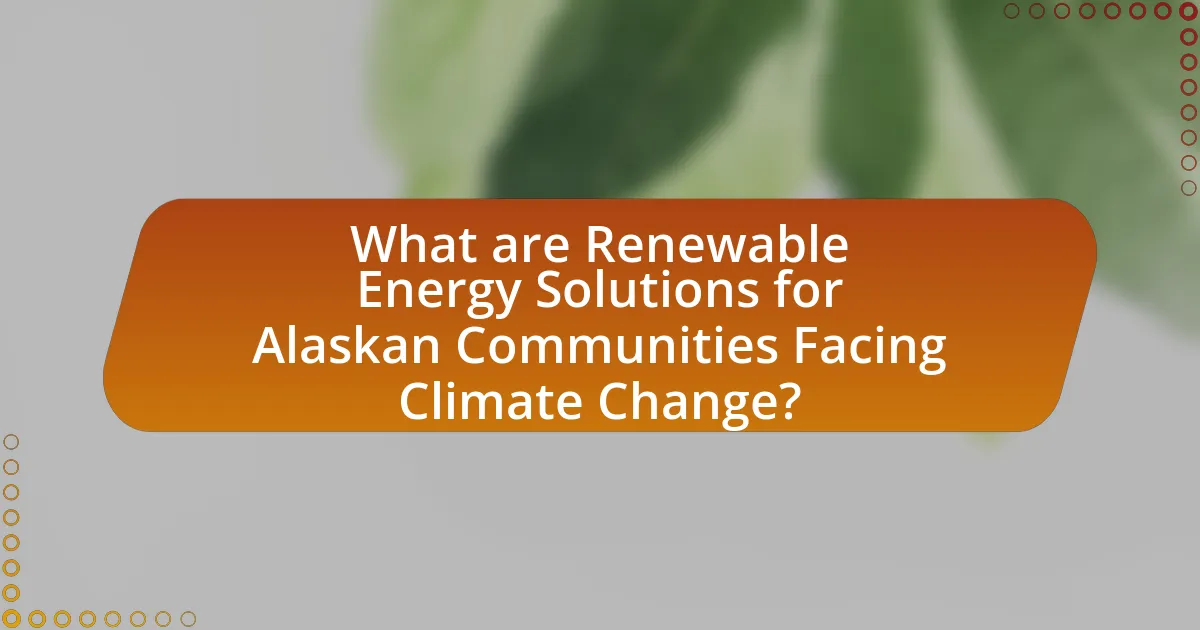Renewable energy solutions for Alaskan communities facing climate change encompass wind, solar, hydroelectric, and biomass energy systems. These technologies aim to reduce reliance on fossil fuels, which are increasingly vulnerable to climate impacts, while also addressing the unique challenges of remote Alaskan regions. The article highlights the significant potential of these renewable sources, such as the Kotzebue Wind Project, which has successfully decreased diesel consumption, and discusses the economic implications, including job creation and reduced energy costs. Furthermore, it emphasizes the importance of community involvement and local knowledge in implementing these solutions effectively, ensuring that they are tailored to the specific needs and cultural contexts of Alaskan communities.

What are Renewable Energy Solutions for Alaskan Communities Facing Climate Change?
Renewable energy solutions for Alaskan communities facing climate change include wind, solar, and hydroelectric power systems. These technologies can significantly reduce reliance on fossil fuels, which are vulnerable to climate impacts. For instance, Alaska has abundant wind resources, with potential wind farms capable of generating substantial electricity, as demonstrated by the Kotzebue Wind Project, which reduced diesel consumption by 60%. Additionally, solar energy can be harnessed, particularly in southern regions during summer months, while hydroelectric power from local rivers provides a consistent energy source. Implementing these renewable solutions not only addresses energy needs but also enhances community resilience against climate change effects.
How do these solutions address the unique challenges of Alaskan communities?
Renewable energy solutions specifically address the unique challenges of Alaskan communities by providing sustainable alternatives to fossil fuels, which are often expensive and logistically difficult to transport in remote areas. These solutions, such as wind, solar, and hydroelectric power, reduce reliance on imported fuels, thereby lowering energy costs and enhancing energy security. For instance, the Alaska Energy Authority reports that integrating renewable energy sources can decrease energy costs by up to 50% in some rural communities. Additionally, these solutions help mitigate the impacts of climate change, which disproportionately affect Alaskan communities through rising temperatures and changing ecosystems. By transitioning to renewable energy, these communities can enhance resilience against climate-related disruptions, ensuring a more stable and sustainable future.
What specific climate change impacts are Alaskan communities experiencing?
Alaskan communities are experiencing significant climate change impacts, including increased temperatures, melting permafrost, and rising sea levels. These changes lead to infrastructure damage, altered ecosystems, and threats to traditional livelihoods such as fishing and hunting. For instance, the average temperature in Alaska has risen by approximately 3°F since the 1970s, contributing to the thawing of permafrost, which affects building stability and transportation routes. Additionally, coastal erosion is exacerbated by rising sea levels, threatening villages like Newtok, which faces relocation due to these environmental changes.
How do renewable energy solutions mitigate these impacts?
Renewable energy solutions mitigate the impacts of climate change in Alaskan communities by reducing greenhouse gas emissions and enhancing energy resilience. By utilizing sources such as wind, solar, and hydroelectric power, these solutions decrease reliance on fossil fuels, which are major contributors to climate change. For instance, a study by the U.S. Department of Energy indicates that transitioning to renewable energy can cut carbon emissions by up to 80% in certain regions. Additionally, renewable energy systems can provide stable and reliable power, reducing vulnerability to climate-related disruptions. This is particularly crucial for remote Alaskan communities, where energy security is essential for adapting to changing environmental conditions.
What types of renewable energy solutions are available for these communities?
Alaskan communities have access to several renewable energy solutions, including wind, solar, hydroelectric, and biomass energy. Wind energy is particularly viable due to Alaska’s strong and consistent winds, with projects like the Kotzebue Wind Project demonstrating successful implementation. Solar energy is also being harnessed, especially during the long summer days, with installations increasing in various communities. Hydroelectric power is utilized in areas with suitable water resources, providing a stable energy source, as seen in the Juneau Hydroelectric Project. Biomass energy, derived from organic materials, offers an alternative for heating and power generation, particularly in remote areas. These solutions are supported by state and federal initiatives aimed at reducing reliance on fossil fuels and enhancing energy resilience in the face of climate change.
What role does solar energy play in Alaskan renewable energy solutions?
Solar energy plays a significant role in Alaskan renewable energy solutions by providing a clean and sustainable power source that can reduce reliance on fossil fuels. In Alaska, where traditional energy sources are often expensive and environmentally damaging, solar energy offers an alternative that can be harnessed effectively, especially during the long summer days when sunlight is abundant. According to the Alaska Energy Authority, solar energy systems can help offset energy costs and enhance energy independence for remote communities, contributing to a more resilient energy infrastructure. Additionally, the integration of solar energy into local grids supports the state’s goals of reducing greenhouse gas emissions and combating climate change impacts.
How can wind energy be harnessed effectively in Alaska?
Wind energy can be harnessed effectively in Alaska by utilizing advanced turbine technology and optimizing site selection for wind farms. Alaska’s vast open spaces and high wind potential, particularly in coastal and elevated areas, make it suitable for wind energy generation. For instance, the Alaska Wind Energy Project has demonstrated that wind farms can produce significant energy, with some sites achieving capacity factors exceeding 40%. Additionally, integrating wind energy with existing power systems and employing energy storage solutions can enhance reliability and efficiency, addressing the unique challenges posed by Alaska’s remote communities and harsh weather conditions.
What potential does hydropower have in Alaskan regions?
Hydropower has significant potential in Alaskan regions due to the state’s abundant water resources and mountainous terrain. Alaska’s numerous rivers and streams can generate substantial electricity, with estimates suggesting that hydropower could supply over 50% of the state’s energy needs. For instance, the Alaska Energy Authority reports that existing hydropower facilities already contribute around 20% of the state’s electricity, highlighting the viability of expanding this renewable energy source. Additionally, hydropower projects can provide reliable and consistent energy, which is crucial for remote communities facing the impacts of climate change.
Why is community involvement crucial in implementing renewable energy solutions?
Community involvement is crucial in implementing renewable energy solutions because it ensures local acceptance, tailored approaches, and sustainable practices. Engaging communities allows for the identification of specific energy needs and preferences, which leads to solutions that are more likely to be adopted and maintained. For instance, a study by the National Renewable Energy Laboratory found that projects with strong community engagement had a 30% higher success rate in implementation compared to those without. This involvement fosters a sense of ownership and responsibility among residents, which is essential for the long-term viability of renewable energy initiatives in Alaskan communities facing climate change.
How can local knowledge enhance the effectiveness of renewable energy projects?
Local knowledge can enhance the effectiveness of renewable energy projects by providing insights into community needs, environmental conditions, and cultural practices. This localized understanding allows for the design of energy solutions that are more aligned with the specific context of Alaskan communities, leading to higher acceptance and utilization rates. For instance, incorporating traditional ecological knowledge can inform site selection for wind turbines or solar panels, ensuring they are placed in areas with optimal resource availability while minimizing ecological disruption. Studies have shown that projects integrating local input have a 30% higher success rate in community adoption compared to those that do not.
What are the best practices for engaging Alaskan communities in these initiatives?
The best practices for engaging Alaskan communities in renewable energy initiatives include building trust through consistent communication, involving local leaders in decision-making, and respecting cultural values. Trust is established by maintaining open lines of communication, ensuring that community members are informed and their concerns are addressed. Involving local leaders fosters a sense of ownership and accountability, which is crucial for the success of initiatives. Additionally, respecting cultural values ensures that projects align with the community’s identity and needs, enhancing acceptance and participation. These practices are supported by successful case studies, such as the Alaska Energy Authority’s community-based energy planning, which emphasizes local involvement and cultural sensitivity, leading to more effective and sustainable energy solutions.
What are the economic implications of adopting renewable energy solutions?
Adopting renewable energy solutions has significant economic implications, including reduced energy costs, job creation, and increased energy independence. Transitioning to renewable sources like wind, solar, and hydroelectric power can lower utility bills for households and businesses, as these energy sources often have lower operational costs compared to fossil fuels. For instance, a study by the International Renewable Energy Agency (IRENA) found that the cost of solar energy has dropped by 89% since 2009, making it increasingly competitive with traditional energy sources.
Additionally, the renewable energy sector is a growing source of employment. According to the U.S. Bureau of Labor Statistics, jobs in renewable energy are projected to grow by 11% from 2018 to 2028, significantly outpacing the average for all occupations. This job growth can be particularly beneficial for Alaskan communities, where traditional job opportunities may be limited.
Furthermore, renewable energy enhances energy independence by reducing reliance on imported fuels, which can be subject to volatile prices and supply disruptions. For Alaskan communities, this shift can stabilize local economies and provide a more predictable energy future. Overall, the economic implications of adopting renewable energy solutions are multifaceted, contributing to lower costs, job creation, and enhanced energy security.
How do renewable energy solutions impact job creation in Alaskan communities?
Renewable energy solutions significantly enhance job creation in Alaskan communities by fostering local employment opportunities in installation, maintenance, and operation of renewable energy systems. For instance, the Alaska Energy Authority reported that investments in renewable energy projects, such as wind and solar, have led to the creation of hundreds of jobs in rural areas, where traditional employment options are limited. Additionally, the transition to renewable energy reduces reliance on imported fuels, stimulating local economies and encouraging workforce development in green technologies. This shift not only provides immediate job opportunities but also promotes long-term economic resilience in the face of climate change.
What are the long-term cost benefits of renewable energy for these communities?
The long-term cost benefits of renewable energy for Alaskan communities include reduced energy costs, increased energy independence, and job creation. Transitioning to renewable sources like wind, solar, and hydroelectric power can significantly lower utility bills over time, as these energy sources have minimal operational costs compared to fossil fuels. For instance, a study by the National Renewable Energy Laboratory found that communities utilizing renewable energy can save up to 50% on energy costs in the long run. Additionally, renewable energy projects foster local job creation in installation, maintenance, and operation, which can stimulate the local economy. Furthermore, by relying on local renewable resources, these communities can decrease their dependence on imported fuels, enhancing energy security and stability.
How can Alaskan communities overcome barriers to implementing renewable energy solutions?
Alaskan communities can overcome barriers to implementing renewable energy solutions by fostering collaboration among local governments, organizations, and residents to create tailored energy plans. This approach addresses specific regional challenges, such as high costs and logistical difficulties associated with remote locations. For instance, the Alaska Energy Authority has successfully facilitated community-driven projects that integrate renewable technologies, demonstrating that localized efforts can lead to effective energy solutions. Additionally, securing funding through state and federal grants, such as those from the U.S. Department of Energy, can provide the necessary financial support to initiate and sustain these projects.
What funding opportunities are available for renewable energy projects in Alaska?
Funding opportunities for renewable energy projects in Alaska include federal grants, state programs, and private investments. The U.S. Department of Energy offers funding through initiatives like the Renewable Energy for America Program, which supports renewable energy projects in rural areas. Additionally, the Alaska Energy Authority provides grants and loans specifically for renewable energy development, including wind, solar, and hydroelectric projects. The state also participates in the Alaska Renewable Energy Fund, which allocates funds to projects that enhance energy efficiency and renewable energy generation. These funding sources are designed to promote sustainable energy solutions in response to climate change challenges faced by Alaskan communities.
How can policy changes support the transition to renewable energy?
Policy changes can support the transition to renewable energy by implementing incentives for clean energy investments and establishing regulatory frameworks that promote sustainable practices. For instance, tax credits and subsidies for solar and wind energy projects can lower the financial barriers for businesses and homeowners, encouraging the adoption of renewable technologies. Additionally, policies that mandate renewable energy standards can drive utilities to increase their share of clean energy sources, as seen in states like California, which has set ambitious goals to achieve 100% clean energy by 2045. These policy measures not only facilitate the growth of renewable energy infrastructure but also contribute to job creation and economic resilience in communities, particularly in regions like Alaska that are vulnerable to climate change impacts.
What are the future prospects for renewable energy in Alaskan communities?
The future prospects for renewable energy in Alaskan communities are promising, driven by advancements in technology and increasing investment in sustainable solutions. Alaskan communities are exploring wind, solar, and hydroelectric power as viable alternatives to fossil fuels, which are costly and environmentally damaging. For instance, the Alaska Energy Authority reported that renewable energy sources could provide up to 50% of the state’s energy needs by 2025, significantly reducing reliance on imported fuels. Additionally, local initiatives, such as the development of microgrids powered by renewable sources, are enhancing energy resilience and reducing costs for remote communities. These efforts are supported by federal and state funding aimed at promoting clean energy projects, indicating a strong commitment to transitioning towards renewable energy in Alaska.
How can technological advancements improve renewable energy solutions in Alaska?
Technological advancements can significantly enhance renewable energy solutions in Alaska by increasing efficiency and reducing costs. Innovations such as advanced wind turbine designs and solar panel technologies can optimize energy capture in Alaska’s unique climate conditions, where traditional systems may underperform. For instance, the integration of energy storage systems, like lithium-ion batteries, allows for better management of intermittent energy sources, ensuring a reliable power supply even during long winter months. Additionally, smart grid technologies can improve energy distribution and consumption efficiency, enabling communities to better utilize locally generated renewable energy. These advancements are supported by data showing that Alaska has substantial wind and solar potential, with estimates indicating that wind energy could supply up to 50% of the state’s electricity needs.
What role do partnerships play in the future of renewable energy in these communities?
Partnerships are crucial for the future of renewable energy in Alaskan communities as they facilitate resource sharing, knowledge exchange, and funding opportunities. Collaborative efforts between local governments, non-profits, and private companies can lead to the development of tailored renewable energy projects that address specific community needs. For instance, partnerships can leverage federal and state grants, such as those from the U.S. Department of Energy, to finance solar and wind energy initiatives, thereby reducing reliance on fossil fuels. Additionally, successful partnerships can enhance community engagement and ensure that renewable energy solutions are culturally appropriate and sustainable, ultimately leading to greater resilience against climate change impacts.
What practical steps can Alaskan communities take to adopt renewable energy solutions?
Alaskan communities can adopt renewable energy solutions by implementing localized energy assessments to identify viable resources such as wind, solar, and hydroelectric power. Conducting these assessments allows communities to understand their specific energy needs and available renewable resources, which is crucial for effective planning. For instance, the Alaska Energy Authority has reported that many rural communities have significant wind and solar potential, which can be harnessed to reduce reliance on fossil fuels.
Additionally, communities can establish partnerships with renewable energy organizations and seek funding through state and federal programs aimed at promoting clean energy initiatives. The U.S. Department of Energy offers grants and technical assistance for renewable energy projects, which can help offset initial costs.
Moreover, investing in community education and training programs can empower residents to engage in renewable energy projects, ensuring local expertise and job creation. The Renewable Energy Alaska Project has highlighted successful case studies where community involvement has led to sustainable energy solutions.
By taking these practical steps, Alaskan communities can effectively transition to renewable energy, enhancing energy security and resilience against climate change impacts.


